The Motor Racing Coupe Internationale
Despite the much publicised eccentricities of Gordon Bennett, he was a shrewd and successful business man.
The international motor racing event was initially publicised ahead of time and with each race covered by the New York Herald, and thus the New York Evening Telegram and the European edition of the New York Herald, published in Paris.
The Gordon Bennett Trophy - Made in 1895
The Gordon Bennett Motor racing trophy weighing in at 17 kg depicted a racing Panhard, which at the time was, steered by the Genius of Progress with the Goddess of Victory upright upon the seat created by the Paris silversmith André Aucoc.
The Panhard of “Panhard & Levassor” was one of the world's leading car manufacturers with sustained success in racing from 1895, winning the 1200km Paris-Bordeaux-Paris race in 49 hours.
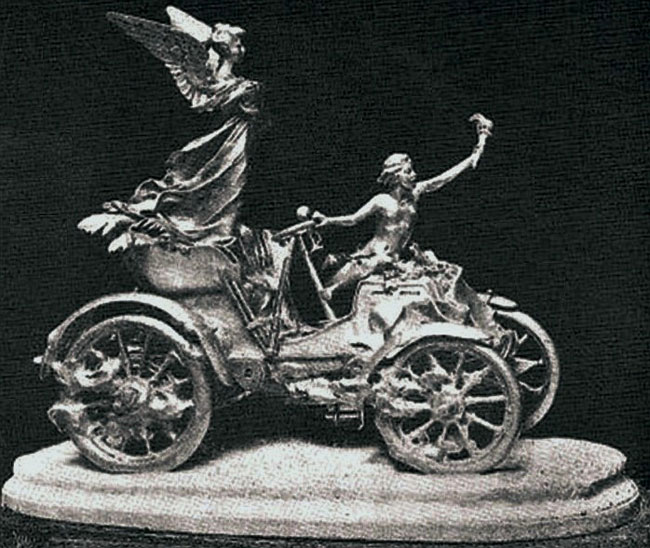
In 1900 the Silver cup was valued at 12,000 francs which had a value equating to £480 or $2333.
Gordon Bennett Race Entry Fee
The race entry fee was 3,000 francs, (£120 or $583) redeemable if one of the registered cars made it to the start line.
1900 Average Earnings
To put things in perspective the average annual wage in 1900 for a male schoolteacher in the USA was in the region of $780.
In France, a city based labourer and carpenter had a daily rate of 2.91 and 5.20 francs respectively.
Level Playing Field
The twenty two entry rules, pre-cursors of the Grand Prix racing as we now know it, to be monitored and enforced by the ACF were very specific and showed vision in presenting a level playing field, the most contentious of which, to the French at least ,was the three-car limit per nation.
Race Rules
- The race was to be between 550 kms and 650kms.
- All races for the cup, either taking place in France or in any other country, to be run and enforced under the racing rules of the Automobile Club de France (ACF), published 1899.
- The competitions would take place each year between 15th May and 15th August.
- At least two passengers with an average weight of 70kg to be seated side by side. Any shortfall in passenger weight would have to be made up of ballast.
- The automobile must weigh more than 400 kilos when empty, the 400 kilos to exclude the weight of passengers, supplies ( coal, petroleum, water, accumulators) and tools, spare fittings, luggage, clothing or provisions.
- Every part of the automobiles must be constructed entirely in the respective countries of the competitors (including tyres) and be constructed by members of the competing clubs.
- The winner of each race would host the following years race either in their respective country or France.
- The Cup would be retained each year by the victor.
- Each club can be represented by one, two or three automobiles at will, but the fact that only one or two automobiles of a club should start cannot deter the other clubs from their right to have three cars to compete.
- In addition, to distinguish the cars, each one had to display the national colour.
Les Bleus
Initially this was blue for France, white for Germany, green for the British Isles, black for Italy, and red for the United States (this would subsequently be allocated to Italy).
World Supremacy
At the time France was the world’s leading car maker, a position which would remain undisputed for some years to come.
The clubs recognised to receive entries by the Automobile Club of France (ACF) were:
- The Automobile Club of America
- The Automobile Club of Austria
- The Automobile Club of Belgium
- The Automobile Club of Germany
- The Automobile Club of Great Britain
- The Automobile Club of Switzerland
- The Automobile Club of Turin.
The French auto manufacturers had a huge problem with one particular aspect of the Gordon Bennett rules, which they didn't have to worry about with the City to City races and that was the 3 car entry per nation, which was perfectly understandable from their point of view.
Particularly galling to the them was Germany entering two Mercedes and an Opel in 1904 with Austria entering three Mercedes. In 1905, both countries entered three Mercedes being manufactured in both countries.
In 1904 France had over 180 Car Brands.
Compared to the rest of the world and they were getting tested in trials on a regular basis, driving on roads completely unfit for purpose, absolute hell for the drivers, but the terrain was really testing the durability of the vehicles with the constant shocks and vibration that pummeled the engine and chassis,generating many factory improvements to vehicle technology.
Following a motor race in April 1900 which left two spectators injured, one of whom was the wife of the Deputy for the Department of the Seine, a racing ban was applied initially for that department, and then nationwide.
After lobbying by the Automobile Club de France (ACF) an exemption was granted on 12th June, just two days before the race.
1900 14th June Paris 0300hrs - First Gordon Bennett Cup Race
The Paris - Lyons had a very poor showing in year one, with only five out of seven entries who actually started the race. It was deemed a failure, principally through poor organisation and short notice.
Fernand Charron was driving the first of the only two cars, both Panhard's, to complete the race with an average speed of 62.12 km/h
Two Belgian entries, a Panhard and a Snoeck-Bolide, and a USA Winton all retired.
The Winton was driven by the same Alexander Winton who had challenged Fernand Charron in 1889 to travel to the USA to race against him after Charron had added the the Paris–Bordeaux race win to his two city to city victories of Marseille–Nice and Paris–Amsterdam–Paris in 1888.
Gordon Bennett had been requested to mediate the challenge at the time, but it came to nothing as Charron thought the purse offered was insufficent to justify the trip.
It was decided that for the next two races the event would run concurrently with an open race, which was just as well.
1901 29th May - Second Race
The second Gordon Bennet Cup was run at the same time as the 527km “open” Paris-Bordeaux race.
Britain Disqualified
The German entry did not materialize and the British (Selwyn Edge) Napier entry was disqualified for adopting French tyres as the fitted Dunlops were suspect in being able to support the weight of the Napier, compromising the “100% made in country of origin” rule.
This left three French cars of which only one, a Panhard driven by Léonce Giradot completed the course averaging 59.53km/h, hardly a noteworthy event.
Worse still was that Henri Fournier winner of the open race driving his Mors averaged 25km per hour faster than the Panhard.
1902 26th-28th June - Third Gordon Bennett Cup Race
Paris-Innsbruck Once again the race was scheduled to run concurrently, this time with the Paris-Vienna race which had 213 entries.
There were six Gordon Bennett entries, three from France and three from Britain who would stop racing at Innsbruck, having completed 561km, 186 km short of the open race endpoint in Vienna.
The Paris Innsbruck Gordon Bennet route was split over three days terminating on day one at Belfort, France after 375 km. Then Switzerland, which had a racing ban on open roads, and did not count, was crossed on day two at 15mph and on the third day, the race was resumed on the second and final 186km leg from Bregenz to Innsbruck.
The six entries from Britain and France, consisted of two Wolseley's, a Napier, a Panhard, a Mors and the 1900 winner Fernand Charron, driving a Charron-Girardot-Voigt (CGV)
The Six Gordon Bennett Races
A British Win
France, two time winners, were not only beaten by the British Napier (Selwyn Edge) in 1902, but did not get any cars to finish, neither in fact did either of the two Wolseleys.
The UK would host it in 1903 and Napier sales would triple over the next year as would British car exports overall.
International Entries Double
From the point of Selwyn Edge winning in the British Napier and moving the race to the UK, entries doubled to 12 entries from four countries. Each of those countries entries had run the gauntlet of elimination trials.
With France beaten the following years Gordon Bennett Cup race was to be held in the UK.
High Death Toll in French Race Invokes Europe Wide Ban
The first leg of an open race on public roads between Paris and Bordeaux injured one hundred spectators and cost the lives of five race drivers and two spectators.
The race on Sunday 24th May 1903 with an intended route of Paris to Madrid involving over 200 cars and motorcycles, was cancelled at Bordeaux and the Spanish border closed to race cars.
Cars were not allowed to be restarted and towed by horses to be despatch by train back to Paris.
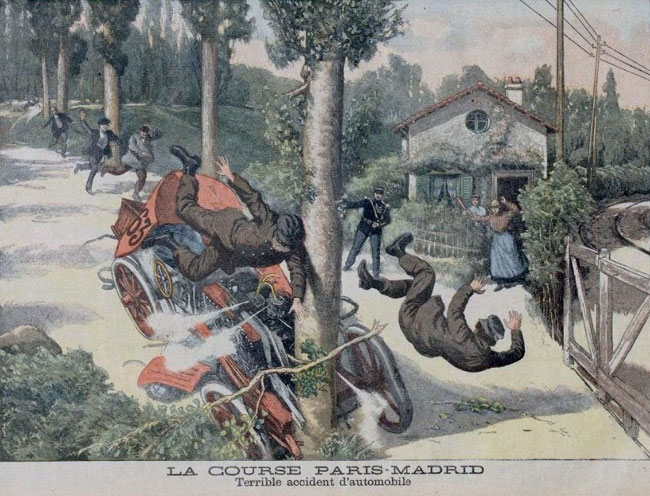 Newspaper Illustration of the May 1903 tragedy
Newspaper Illustration of the May 1903 tragedy
The British Government stated that the Irish race would proceed as previously published.
Europe looked on and moved on, after all there was the The Royal Belgian AC Ardennes Circuit race in June and all the regulars would be there.
1903 2nd July - Ireland - Fourth Gordon Bennett Cup Race
After the victory of a Napier driven by Selwyn Edge in 1903, the circuit, on public roads was set up, not in England's 14mph roads, but in Ireland, around the town of Athy southwest of Dublin.
The Light Locomotive (Ireland) Act passed in March 1903 allowed the Athy-Kildare Loop to be legally closed, turning it into the first closed-loop racing circuit ever used for a single day of unlimited speed.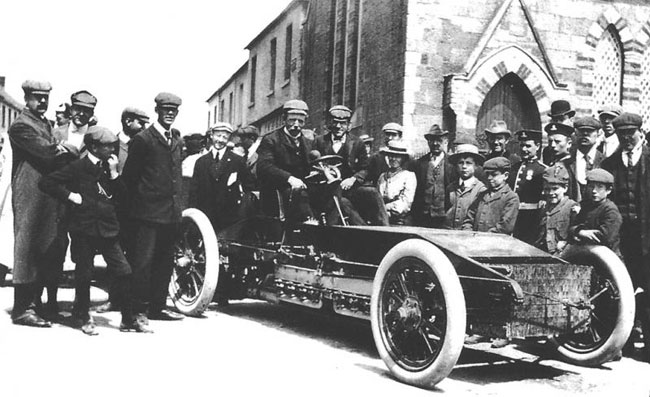
American Alexander Winton in Ireland in the 8 cylinder Bullet No.2
In an extract from The Times; “however, the whole length of the road upon which the race will take place is only 93 miles, and it has already been arranged that the road shall be kept clear by 7,000 police officers, assisted by troops and club stewards".
Significant manpower was devoted to improving the Kildare & Carlow course circuit public road surfaces.
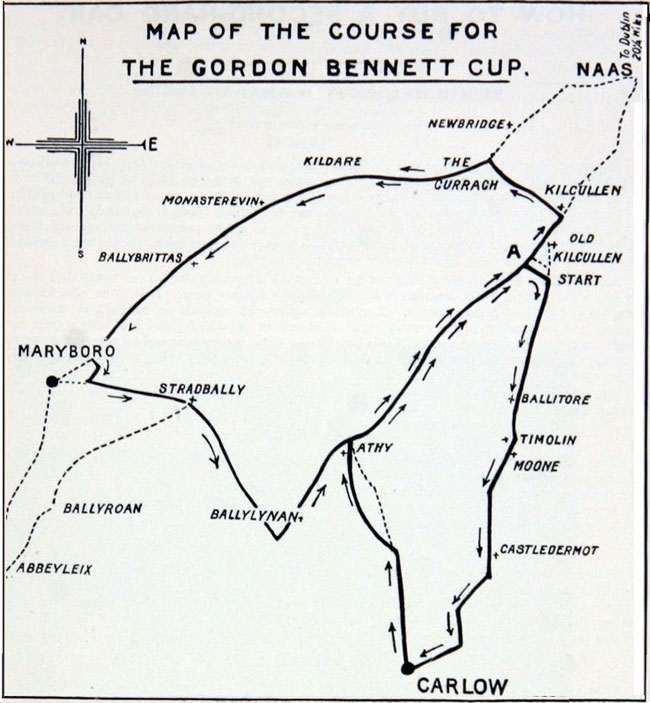
The Athy-Kildare Loop
A Pint of beer had never been so expensive
The world and his wife and a hundred journalists flocked to Ireland, where a pint of beer and nearly everything else was sold at a hitherto unknown price.
Fifteen hundred visitors and their cars arrived by boat alone but the closed circuit event attracted 150,000 people and a huge boost to the local and national economy.
Germany, France, The USA and Britain each entered three vehicles.
The French team finished in 2nd, 3rd and 4th positions.
Germany took the win in a Mercedes driven by Camille Jenatzy who achieved an average speed of 79.16 km/h better. but Henri Fournier was still 6km/h ahead.
Mercedes regarded the race victory as pivotal in it's international presence.
Huge Success
The organisation of the race was a huge success. It was the first international race on a legally, fully closed circuit with race marshals and spectator control.
The Racing Circuit Template had been Established.
1904 17th June - Fifth Race - Germany
The next race was therefore held in Germany, northwest of Frankfurt in Taunus, with 18 starters from eight countries, with Germany defending against Belgium, France, Great Britain, Austria and Italy.
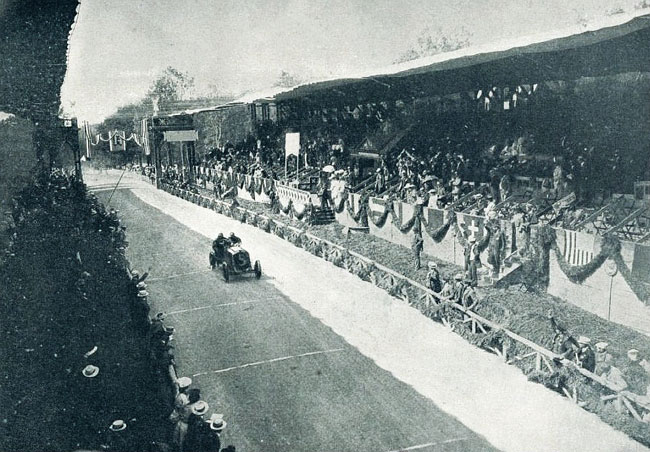
Léon Théry passing in front of the German Emperor's rostrum in 1904.
French driver Léon Théry won in a Richard-Brasier Car an average speed surpassing 94.34 km/h with a fastest time of 150km/h on the Obertiefenbach-Limburg stage.
The spectator stand held 2,500 people with one million people in attendance.
Superb Race Organisation in Germany
The route includes passage through eight “neutralised towns”, where each car is allocated a dedicated cyclist on arrival who precedes the car at a set pace between the incoming and outgoing town borders.
1905 5th July - Sixth and Final Gordon Bennet Cup Race
The race returned back to France in 1905 for a final installment on a circuit in Auvergne with 80,000 spectators lining the circuit designed by the Michelin brothers who were headquartered in nearby Clermont-Ferrand.
Léon Théry was victorious again in a Richard-Brasier Car with an average speed of 77.98 km/h
Twelve out of eighteen entries completed the race with France defending against Germany, Great Britain, Austria, Italy and the USA.
A Wolsey coming in 8th was Britains best placed nearly an hour and a half after Léon Théry who completed the 549.4km route in 7hrs, 2minutes and 43 seconds.
With four out of the six trophies being won by France and the desire to switch to a format enabling an unlimited number of cars per country 1905 was the last Gordon Bennett motor racing event and the trophy is conserved in Paris.
The 1906 event would be held in Le Mans and would be the first Grand Prix.